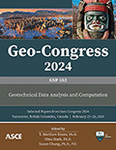Site Investigation Database for Geophysical and Geotechnical Data Collected on a USCS SM Soil Type
Publication: Geo-Congress 2024
ABSTRACT
Engineers need to know the strength of soil to support current and future infrastructure, that is, roads and buildings, to determine if the infrastructure will persist or fail. Geophysical tests offer a nondestructive standoff method that can be used to characterize and monitor soil properties. To begin this process, a database of geophysical and geotechnical values for common geotechnical soil types is needed to aid in site characterization. This project’s research goal was to record, collect, and share experimental geophysical and geotechnical data for publication in a reference database with Unified Soil Classification System (USCS) soil types. We performed geophysical field tests, near the Pemigewasset River near Bristol, NH, on unfrozen soil utilizing seismic methods, ground-penetrating radar, electrical resistivity tomography, electromagnetic induction, standard penetration tests (in progress), and boreholes (in progress) to obtain laboratory samples and ground truthing. We are compiling a database, to aid researchers and engineers when characterizing site soils from ground response information and provide a base dataset for modeling soil behavior.
Get full access to this article
View all available purchase options and get full access to this chapter.
REFERENCES
Al-Heety, A. J., Hassouneh, M., and Abdullah, F. M. (2021). “Application of MASW and ERT methods for geotechnical site characterization: A case study for roads construction and infrastructure assessment in Abu Dhabi UAE.” Journal of Applied Geophysics, 193, 104408, ISSN 0926-9851.
Cha, M., and Cho, G. C. (2007). “Shear strength estimation of sandy soils using shear wave velocity.” Geotechnical Testing Journal, 30(6), 484–495.
Conyers, L. B., and Cameron, C. M. (1998). “Ground-penetrating radar techniques and three-dimensional computer mapping in the American Southwest.” Journal of Field Archaeology, 25(4), 417–430.
Doolittle, J. A., Windhorn, R. D., Withers, D. L., and McLeese, R. L. (2009). “High‐Intensity Soil Mapping with the Aid of EMI in Northern Illinois.” Soil survey horizons, 50(2), 68–74.
Ghafghazi, M., and Shuttle, D. (2008). “Interpretation of sand state from cone penetration resistance.” Géotechnique, 58(8), 623–634.
Glaser, D. R., Burch, K., Brinkley, D. L., and Reppert, P. (2021). “Localization of deep voids through geophysical signatures of secondary dewatering features.” Geophysics, 86(3), WA139–WA152.
Madun, A., Tajuddin, S. A. A., Abdullah, M. E., Abidin, M. H. Z., Sani, S., Siang, A. J. L. M., and Yusof, M. F. (2016). “Conversion shear wave velocity to standard penetration resistance.” In IOP Conference Series: Materials Science and Engineering, IOP Publishing 012009, 136(1).
Matthews, M. C., Hope, V. S., Clayton, C. R. I., and RAYLEIGH. (1996). “The use of surface waves in the determination of ground stiffness profiles.” Proceedings of the Institution of Civil Engineers-Geotechnical Engineering, 119(2), 84–95.
Oh, S., and Sun, C. G. (2008). “Combined analysis of electrical resistivity and geotechnical SPT blow counts for the safety assessment of fill dam.” Environmental Geology, 54, 31–42.
Park, C. B., Miller, R. D., and Xia, J. (1999). Multichannel analysis of surface waves. Geophysics, 64(3), 800–808.
Parnadi, W. W., Warsa, W., Laesanpura, A., Parnadi, R. G., and Asaue, H. (2018, April). “Correlating ground-penetrating radar data with geotechnical data.” In 2018 2nd International Conference on Applied Electromagnetic Technology (AEMT), 8–11. IEEE.
Pegah, E., and Liu, H. (2016). “Application of near-surface seismic refraction tomography and multichannel analysis of surface waves for geotechnical site characterizations: A case study.” Engineering Geology, 208, 100–113.
Rohani, B., and Baladi, G. Y. (1981). Correlation of mobility cone index with fundamental engineering properties of soil.
Rucker, M. (2006). “Integrating seismic refraction and surface wave data collection and interpretation for geotechnical site characterization.” Geophysics, 4–7.
SW, E. (2000). ASTM D 1452, 20 ASTM D 1586, 19 ASTM D 1587, 20 ASTM D 4387, 19 ASTM D 4448, 19-20.
Tihey, L., and Kim, S. S. (2020). “Estimation of Resilient Modulus for Fine-Grained Soils Using Ground Penetrating Radar.” In Proceedings of the 9th International Conference on Maintenance and Rehabilitation of Pavements—Mairepav9. 741–750. Springer International Publishing.
Williams, R. R., and Nazarian, S. (2007). “Correlation of resilient and seismic modulus test results.” Journal of materials in civil engineering, 19(12), 1026–1032.
Yılmaz, Ö., et al. (2008). “Shallow seismic and geotechnical site surveys at the Turkish national grid for strong-motion seismograph stations.” In 14th world conference on earthquake engineering, Beijing, China.
Xia, J., Miller, R. D., Park, C. B., Hunter, J. A., Harris, J. B., and Ivanov, J. (2002). “Comparing shear-wave velocity profiles inverted from multichannel surface wave with borehole measurements.” Soil dynamics and earthquake engineering, 22(3), 181–190.
Information & Authors
Information
Published In
History
Published online: Feb 22, 2024
ASCE Technical Topics:
Authors
Metrics & Citations
Metrics
Citations
Download citation
If you have the appropriate software installed, you can download article citation data to the citation manager of your choice. Simply select your manager software from the list below and click Download.
